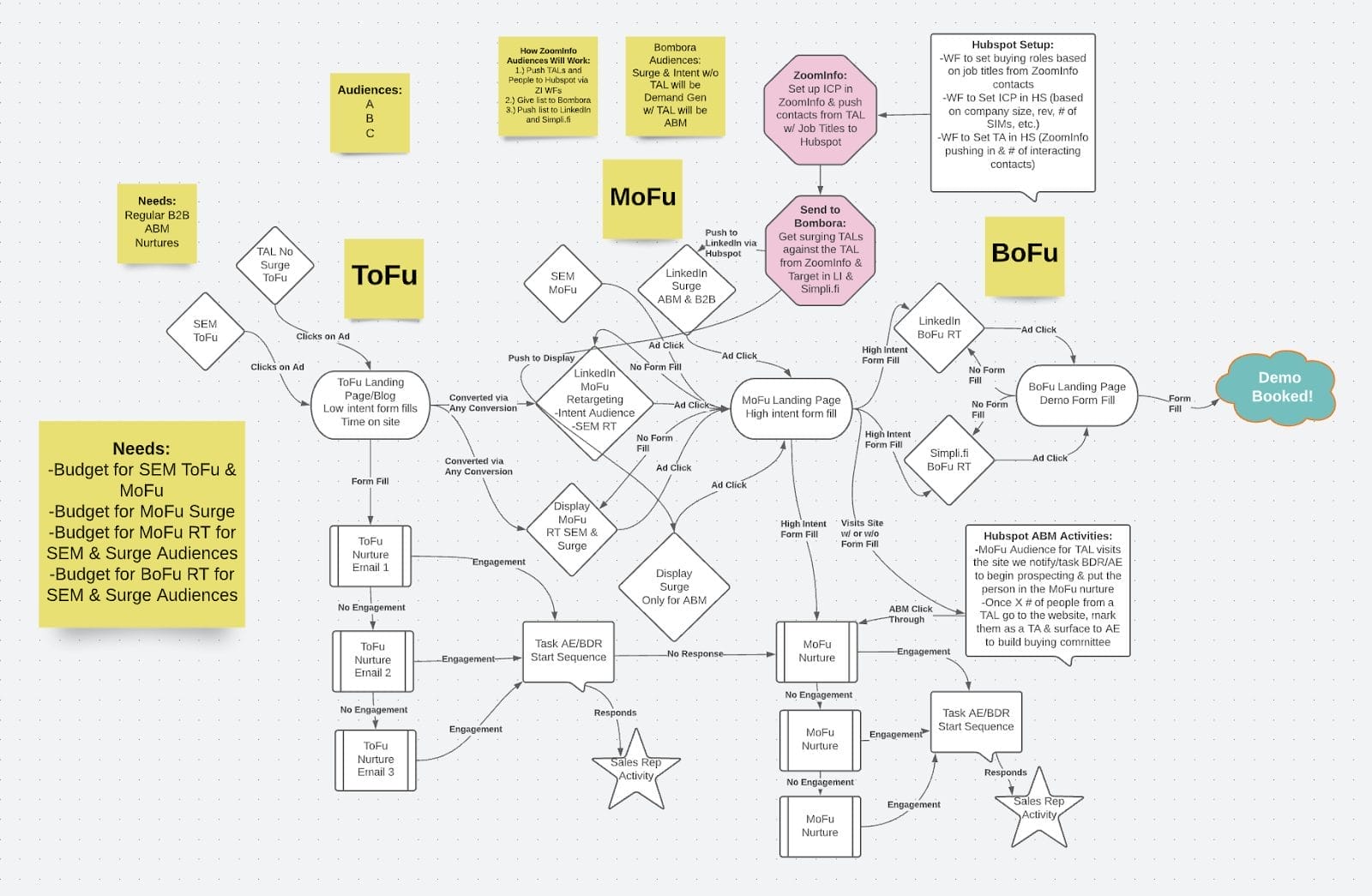Account-based marketing is a pivotal tool for marketers, especially when dealing with high Annual Contract Values (ACV) and limited market opportunities. The success of account-based marketing hinges on collaboration between marketing and sales teams, making it imperative for everyone involved to have a common understanding of its concepts, tools, and techniques.
In this first part of this series, we’ll explore the world of account-based marketing, its history, what it is, and how to execute it effectively using HubSpot.
A Glimpse into Account-Based Marketing (ABM) History
The origins of ABM are debatable, but it was officially introduced by the IT Services Marketing Association (ITSMA) in 2003, followed by the influential 2004 paper “Account-Based Marketing: The New Frontier.” Despite its enduring relevance, ABM remains primarily misunderstood by modern marketers.

Reference: itsma.com
What Account-Based Marketing Is Not
ABM is not a stand-alone practice but a framework encompassing various marketing strategies, including inbound, demand generation, webinars, content campaigns, and in-person events. It is also not synonymous with demand generation, intent data usage, or account planning.
ABM is all about hyper-personalized marketing that effectively aligns marketing and sales efforts to target specific accounts.

Reference: Accenture
Marketing and sales work closely to ensure a seamless and relevant customer experience throughout the buyer’s journey. This includes everything from the first impression at the top of the funnel (ToFu) to the assets used during the discovery process and beyond. The alignment and focus on the customer and tactics and strategies make Account-Based Marketing (ABM) compelling.
Understanding ABM Acronyms & Jargon
ABM comes with its fair share of jargon and acronyms. Here are some key terms you should know:
- TAL (Target Account List): The high-value accounts you intend to target in your campaigns.
- ICP (Ideal Customer Profile): A profile based on firmographic, technographic, and demographic factors to identify target accounts.
- Buying Committee: The group of stakeholders within target accounts influencing purchasing decisions.
- Air Cover: A marketing strategy to ensure the buying committee sees relevant ads throughout the buyer’s journey.
- Surfacing Leads or Handoffs: The process of passing leads from marketing to sales based on specific criteria.
- Thought Leadership: Demonstrating expertise through various content assets.
- Sales & Marketing Alignment: Collaboration between sales and marketing teams to target accounts effectively.
Getting Started with Account-Based Marketing
To lay a solid foundation for your ABM campaign, follow these steps:
- Identify your Ideal Customer Profile (ICP), create your Target Account List (TAL), and segment it into tiers.
When creating a successful marketing strategy, it’s essential to begin by considering your audience. Who are you trying to reach? You can compile a list of specific accounts or use ICP parameters to generate a matched list from a third-party tool. The key is identifying your target audience and segmenting the list as needed.
- Plan touchpoints and triggers for each segment.
It is essential to build out the buyer’s journey for each ICP tier, buying role, job function, etc. Consider using LucidChart or Miro.

To ensure a successful campaign, it is essential to carefully plan all triggers, conditions, exclusions, and lifecycle stage qualifications. It is recommended to create a thorough and well-thought-out schematic or roadmap. It is better to keep your campaign complete but straightforward rather than incomplete. Also, consider your team’s bandwidth when deciding on the level of segmentation and personalization in your campaigns.
- Align sales and marketing to the handoff process.
Successful ABM campaigns rely heavily on effective handoffs. Sales and marketing teams must clearly understand when sales should engage, how marketing should adjust their efforts accordingly, and whether the handoff process is consistent across all ICP tiers and buying roles. Once these handoff procedures are established, they should be implemented in your CRM and marketing automation platform.
- Deploy your complete strategy & schedule ongoing alignment check-ins.
Double-check all segmenting workflows, lead surfacing conditions, and asset delivery settings before launching your campaign. After testing the setup and pushing the campaign out, regularly monitor your dashboards. To stay aligned, schedule meetings between sales and marketing.
- Iterate and experiment to boost relevance.
After you launch, you must analyze your performance and optimize like you would for any other marketing campaign. In addition to the standard KPIs, you will also want to monitor how your campaigns perform across entire accounts rather than with the individuals who comprise accounts. Keep track of which assets are hitting with which buying roles, job functions, and ICP tiers. Evaluate what handoff patterns deliver the best closed-won opportunities. Collect customer and sales team feedback to gather insights your dashboards don’t tell you.
Executing ABM Campaigns in HubSpot
Here’s how you can leverage HubSpot’s Sales Hub and Marketing Hub for your ABM plays:
- Create a target account list and track account activity in the account overview panel.
- Use workflows to label ICP tiers and buying roles and plan and deploy all campaign touches.
- Utilize smart content, A/B testing, and chatbots for personalized experiences.
- Continuously segment lists and update account targeting based on engagement, intent, and scoring.
- Automate sales team tasks and outreach.
- Research prospects and accounts with the LinkedIn Sales Navigator integration.
- Enroll buying committee members into sequences automatically.
- Suggest personalized content for the buying process.
- Use HubSpot videos in your sales outreach.
- Automate offline marketing with tools like Postal.io and Postalytics.
- Analyze data across the buyer’s journey and implement optimizations.
Why HubSpot is an Ideal Choice for ABM Campaigns
HubSpot is an excellent platform to kickstart your Account-Based Marketing (ABM) initiatives. Its customer-centric approach aligns seamlessly with the core principles of ABM. Let’s delve into the reasons why HubSpot is a natural fit for successful ABM campaigns:
- Single Source of Truth: HubSpot offers a unified view of all your sales and marketing data, ensuring that your teams work with consistent and accurate information. The platform provides specialized ABM tools, default ABM properties, a dedicated target account home, AI-driven Target Account recommendations, an account overview page, and the Operations Hub to maintain data cleanliness and consistency.
- Streamlined Campaign Deployment: HubSpot simplifies the execution of ABM campaigns with its versatile features. You can target companies with ads, customize forms based on company properties, create smart content, design engaging landing pages, run campaigns, send personalized emails, set up workflow automation, and manage company lists efficiently.
- Integrations Galore: HubSpot offers extensive integration options to enhance your ABM efforts. Connect with platforms like Slack to collaborate on account-based projects. Use Postal.io for offline marketing and gift sending. ZoomInfo helps with finding contact information. Bombora provides intent data. Zoom is great for hosting webinars. Clearbit helps enrich account information. LinkedIn Sales Navigator assists with account planning and building. Enhance Salesforce synchronization for ABM campaigns.
- Seamless Handoffs for a Consistent Customer Experience: HubSpot facilitates smooth transitions between marketing and sales. It supports advanced sequences, company scoring, marketing automation for lifecycle stage and lead status management, lead rotation, task management, notifications, custom behavioral events, lead scoring, chatbots/live chat, default workflows, quotes, tasks, meetings, documents, and HubSpot video to ensure that the handoff process is seamless and the customer experience remains top-notch.
- Analytics and Income Attribution: HubSpot offers an extensive array of analytics features, including personalized reports, sales and marketing data analysis, ABM, sales, and marketing tailored dashboards, conversational insights, ad conversion event monitoring, and analytics for web, ads, and social media.
Unlock the Full Potential of ABM with HubSpot
If you’re still deciding whether HubSpot is the right choice for your Account-Based Marketing (ABM) initiatives, we’ve got you covered. The second part of this comprehensive guide will delve deeper into the powerful features and strategies that make HubSpot the ideal platform for ABM campaigns.
What to Expect in Part 2:
- Executing ABM Campaigns with HubSpot: Learn advanced ABM tactics that can skyrocket your campaign’s success, from hyper-personalization to leveraging AI for predictive account targeting.
- Expanding the HubSpot Ecosystem for ABM Campaigns: Learn how to leverage the integrations tool HubSpot offers to build a robust ABM strategy and enhance your marketing efforts.
Stay tuned for the forthcoming second part of this series, where we’ll empower you with the knowledge and tools needed for ABM excellence. If you’re eager to explore all things HubSpot or have questions, don’t hesitate to contact us.
We’re here to assist you on your journey to ABM success.
Resources:
Featured Image: Envato Elements
